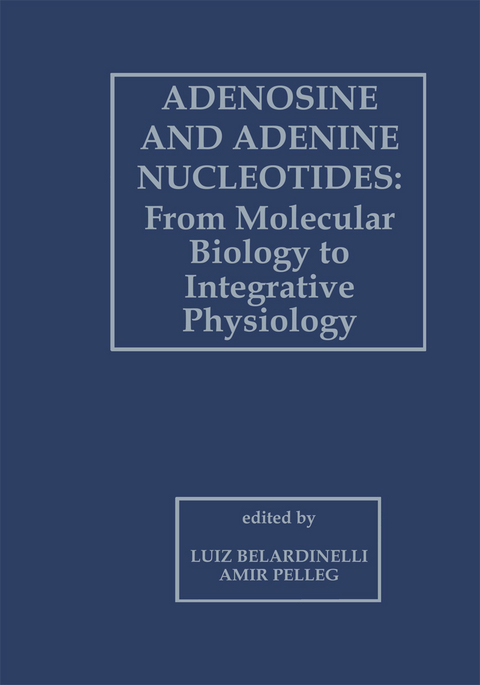
Adenosine and Adenine Nucleotides: From Molecular Biology to Integrative Physiology
Springer-Verlag New York Inc.
978-1-4613-5831-2 (ISBN)
Great emphasis was placed disease. Additional clinical applications of on cutting edge information derived from studies adenosine and adenosine-related drugs and ATP using molecular and cellular biology techniques seem closer than ever before. The editors would like to express their grati- applied to the field of adenosine and adenine nucleotide research. Likewise, the program tude to the distinguished contributors for their included a number of presentations on poten- excellent chapters and to all participants.
I. Molecular and Cellular Biology of Adenosine and ATP.- A. Molecular Biology.- 1. Molecular Biology of Adenosine Receptors.- 2. Recombinant Techniques as Applied to the Study of A1Adenosine Receptors.- 3. In Situ Hybridization of Adenosine Receptors in Brain.- 4. Molecular Modeling of Adenosine A1and A2aReceptors.- 5. Purinoceptor Nomenclature: Challenges for the Future.- 6. Molecular Cloning and Expression of SNST1, a Renal Sodium/Nucleoside Cotransporter.- 7. Antibodies as Probes of Nitrobenzylthioinosine-Sensitive Nucleoside Transporters.- B. Cellular Biology.- 8. Regulation of the Human A1Adenosine Receptor Gene.- 9. Adenosine A2Receptor Regulation of Striatal Gene Expression.- 10. Neuronal ATP Receptors.- 11. Possible Role of Glia in the Induction of CNS-like Properties in Aortic Endothelial Cells: ATP-Activated Channels.- 12. Modulation of Cardiomyocyte Membrane Currents by A1Adenosine Receptors.- 13. Regulation of Phospholipases C and D, Calcium, and Protein Kinase C by Adenosine A1Receptors.- 14. Adenosine Derived from Neurally Released ATP Is the Physiologic Cause of Skeletal Neuromuscular Depression.- 15. Adenosine 5’-Triphosphate Receptor—Mediated Currents in Rat Intracardiac Neurons.- 16. Desensitization of A1Adenosine Receptors.- II. Medicinal Chemistry.- 17. Selective A2Adenosine Receptor Agonists with Potent Inhibitory Activity on Platelet Aggregation.- 18. Novel ATP Agonists Reveal Receptor Heterogeneity within P2xand P2ySubtypes.- 19. Adenosine Receptors: Selective Agonists and Antagonists.- III. Purine Release and Metabolism.- 20. Cardiac Energetics and Adenosine Formation.- 21. Extracellular Hydrolysis of ATP and Formation of Adenosine in the Nervous System.- 22. P-Glycoprotein Serves as a Transporter of Cellular ATP.- 23. On the Origin ofExtracellular ATP in Cardiac Blood Vessels: A Dual Role for Endothelium.- 24. Aliosteric Modulation of Nucleoside Transport by Adenosine and ATP.- IV. Physiology and Pharmacology of Adenosine and ATP: Effects on Tissue and Organs.- A. Renal System.- 25. Chloride Secretion in the Shark Rectal Gland: A Model for Epithelial Adenosine Receptors.- B. Cardiovascular System.- 26. Myocardial Adenosine Receptors.- 27. Coronary Adenosine Receptors: Subtypes, Localization, and Function.- 28. Biologic Activity of Adenosine A2aReceptor Antagonists.- C. Nervous System (Central and Peripheral).- 29. Role of A2aReceptors in the Hippocampus and Motor Nerve Endings.- 30. Augmentation of Extracellular Adenosine Formation as a Potential Therapeutic Strategy for Preventing Excessive Excitatory Amino Acid Transmission in the Central Nervous System.- 31. Purinoceptors on Glial Cells of the Central Nervous System: Functional and Pathologic Implications.- 32. Inhibitory Action of Adenosine and Adenine Dinucleotides on Synaptic Transmission in the Central Nervous System.- 33. Receptors for ATP at Peripheral Neuroeffector Junctions.- 34. Anatomic-Functional Correlates of Adenosine-5’-Triphosphate Triggered Vagal Depressor Reflex.- 35. Excitatory Effect of Adenosine on Cardiac Sympathetic Afferent Fibers.- 36. Mechanism of Anginal Pain: The Key Role of Adenosine.- D. Other Systems.- 37. The P2ZReceptor and its Regulation of Macrophage Function.- 38. Effects of Purinoceptor Agonists on Insulin Secretion.- V. Cytoprotective Actions of Adenosine.- A. Cardioprotection.- 39. Receptor-Mediated and Metabolic Effects of Adenosine in Ischemic and Postischemic Myocardium.- 40. Role of Activation of Ecto-5’- Nucleotidase for Cardioprotection in Ischemic Preconditioning.- 41. Adenosine Uptake Blockersfor Cardioprotection.- 42. Endothelial Adenosine Receptors Modulate Leukocyte Adhesion: Relevance for Myocardial Reperfusion Damage.- B. Neuroprotection.- 43. Adenosine and Brain Ischemia.- 44. Adenosine Metabolites Are a Source of Oxygen Free Radicals in the Ischemic/Reperfused Rat Brain.- 45. Hyperglycemic Ischemia and Reperfusion: Effects on Adenosine and Adenine Nucleotides.- C. Renal Protection.- 46. Studies on the Mechanism by Which Adenosine Receptor Antagonists Attenuate Acute Renal Failure.- VI. Therapeutic Applications.- A. Cardiovascular.- 47. Clinical Electrophysiology of Adenosine.- 48. Myocardial Imaging during Adenosine Infusion.- 49. Intravenous Adenosine and Lidocaine in the Limitation of Infarct Size: Preliminary Safety Data.- 50. Role of Adenosine in the Phenomenon of Ischemic Preconditioning.- B. Nervous System.- 51. Anticonvulsant Actions of Novel and Reference Adenosine Agonists.- 52. Behavioral Effects of Adenosine Receptor Stimulation.- 53. Evidence for the Existence of Antagonistic Intramembrane Adenosine A2a/Dopamine D2Receptor Interactions in the Basal Ganglia: Analysis from the Network to the Molecular Level.- C. Other Applications.- 54. Role of Adenosine and Adenosine Triphosphate as Anesthetic Adjuvants.- 55. Mechanisms and Therapeutic Actions of Uridine Triphosphate in the Lung.
| Zusatzinfo | XIX, 543 p. |
|---|---|
| Verlagsort | New York, NY |
| Sprache | englisch |
| Maße | 178 x 254 mm |
| Themenwelt | Medizin / Pharmazie ► Allgemeines / Lexika |
| Medizinische Fachgebiete ► Innere Medizin ► Kardiologie / Angiologie | |
| Medizinische Fachgebiete ► Innere Medizin ► Nephrologie | |
| Medizin / Pharmazie ► Medizinische Fachgebiete ► Pharmakologie / Pharmakotherapie | |
| ISBN-10 | 1-4613-5831-0 / 1461358310 |
| ISBN-13 | 978-1-4613-5831-2 / 9781461358312 |
| Zustand | Neuware |
| Informationen gemäß Produktsicherheitsverordnung (GPSR) | |
| Haben Sie eine Frage zum Produkt? |
aus dem Bereich


